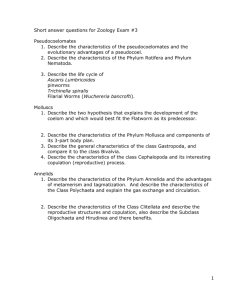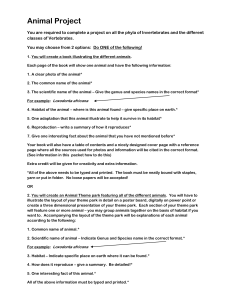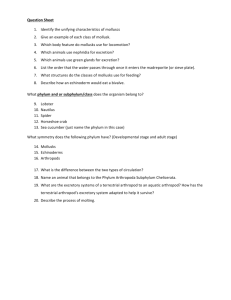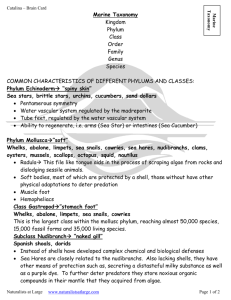word
advertisement
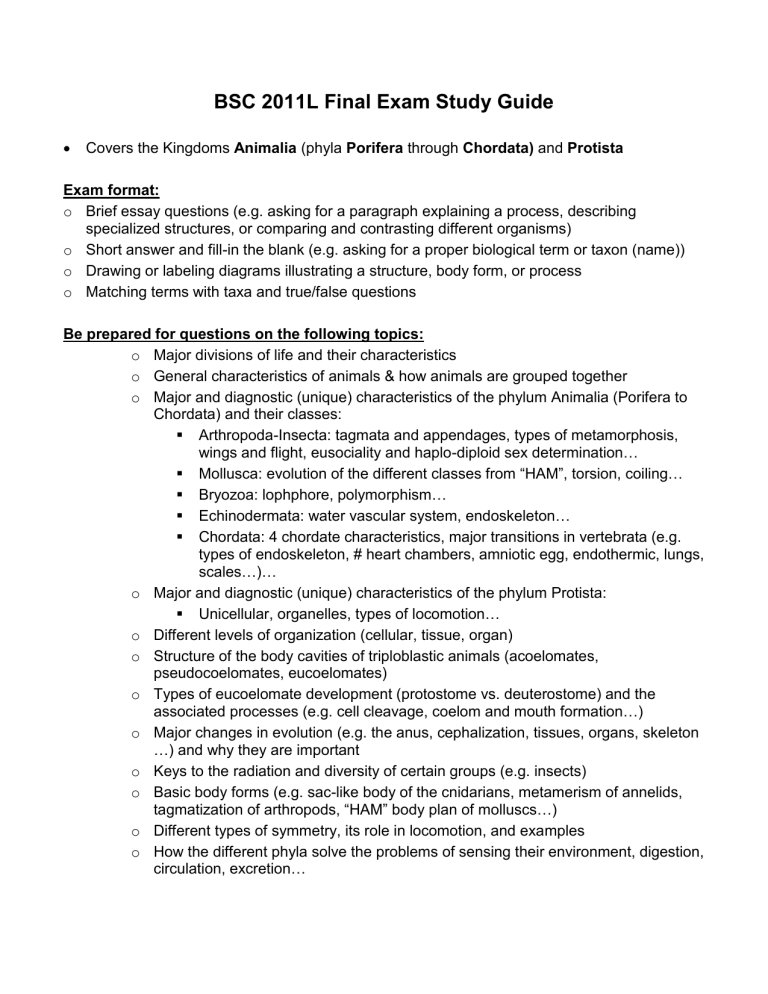
BSC 2011L Final Exam Study Guide Covers the Kingdoms Animalia (phyla Porifera through Chordata) and Protista Exam format: o Brief essay questions (e.g. asking for a paragraph explaining a process, describing specialized structures, or comparing and contrasting different organisms) o Short answer and fill-in the blank (e.g. asking for a proper biological term or taxon (name)) o Drawing or labeling diagrams illustrating a structure, body form, or process o Matching terms with taxa and true/false questions Be prepared for questions on the following topics: o Major divisions of life and their characteristics o General characteristics of animals & how animals are grouped together o Major and diagnostic (unique) characteristics of the phylum Animalia (Porifera to Chordata) and their classes: Arthropoda-Insecta: tagmata and appendages, types of metamorphosis, wings and flight, eusociality and haplo-diploid sex determination… Mollusca: evolution of the different classes from “HAM”, torsion, coiling… Bryozoa: lophphore, polymorphism… Echinodermata: water vascular system, endoskeleton… Chordata: 4 chordate characteristics, major transitions in vertebrata (e.g. types of endoskeleton, # heart chambers, amniotic egg, endothermic, lungs, scales…)… o Major and diagnostic (unique) characteristics of the phylum Protista: Unicellular, organelles, types of locomotion… o Different levels of organization (cellular, tissue, organ) o Structure of the body cavities of triploblastic animals (acoelomates, pseudocoelomates, eucoelomates) o Types of eucoelomate development (protostome vs. deuterostome) and the associated processes (e.g. cell cleavage, coelom and mouth formation…) o Major changes in evolution (e.g. the anus, cephalization, tissues, organs, skeleton …) and why they are important o Keys to the radiation and diversity of certain groups (e.g. insects) o Basic body forms (e.g. sac-like body of the cnidarians, metamerism of annelids, tagmatization of arthropods, “HAM” body plan of molluscs…) o Different types of symmetry, its role in locomotion, and examples o How the different phyla solve the problems of sensing their environment, digestion, circulation, excretion… o Adaptations for different feeding modes (e.g. filter-feeding, prey capture…) and examples o Adaptations to particular environments (e.g. marine, underground…) and examples o Different modes of reproduction (e.g. asexual vs. sexual, monoecious vs. dioecious, internal vs. external fertilization, parthenogenesis…) and examples o Symbiosis and examples of the 3 types o Adaptations for a parasitic lifestyle and examples o Polymorphism and examples (e.g. polyp and medusa body types, colonial polymorphism…) o Complex lifecycle and examples o Types of segmentation and examples (proglottids, metamerism, tagmatization…) o Homology, analogy, and serial homology: definitions and examples o Natural selection and types (directional, stabilizing, disruptive) o Genetic drift o Types of speciation: definitions and examples Kingdom Protista Phylum Sarcomastigophora Subphylum Sarcodina Subphylum Mastigophora Phylum Ciliophora Phylum Sporozoa Kingdom Animalia Phylum Porifera Body types Asconoid, Syconoid, Leuconoid Phylum Cnidaria Class Hydrozoa Class Scyphozoa Class Anthozoa Phylum Platyhelminthes Class Turbellaria Class Trematoda Class Cestoda Phylum Nemertea Phylum Nematoda Phylum Rotifera Phylum Annelida Class Polychaeta Class Oligochaeta Class Hirudinea Phylum Arthropoda Subphylum Trilobita (Trilobitomorpha) Subphylum Chelicerata Class Arachnida Class Merostomata Class Pycnogonida Subphylum Crustacea Class Branchiopoda Class Ostracoda Class Copepoda Class Cirripedia Class Malacostraca Subphylum Uniramia Class Chilopoda Class Diplopoda Class Insecta Subclass Aptyerygota Subclass Pterygota Division Endopterygota Orders Coleoptera, Lepidoptera, Hymenoptera, Diptera Division Exopterygota Orders Orthoptera, Isoptera, Odonata, Hemiptera, Homoptera Phylum Mollusca Class Gastropoda Subclass Prosobranchia Subclass Opisthobranchia Subclass Pulmonata Class Bivalvia Class Cephalopoda Class Polyplacophora Class Scaphopoda Phylum Bryozoa Phylum Echinodermata Class Asteroidea Class Echinoidea Class Ophiuroidea Class Holothuroidea Class Crinoidea Phylum Chordata Subphylum Urochordata Subphylum Cephalochordata Subphylum Vertebrata Class Agnatha Class Chondrichthyes Class Osteichthyes Class Amphibia Class Reptilia Class Aves Class Mammalia


